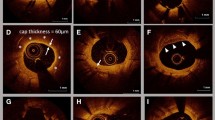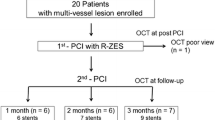Abstract
Morphologic changes of small-sized post-stent malapposition have not been sufficiently evaluated. We investigated serial changes of minimal post-stent malapposition with a follow-up optical coherence tomography (OCT) study. Post-stent OCT and intravascular ultrasound (IVUS) and follow-up OCT were performed in 26 patients with minimal post-stent malapposition. Serial changes of number and percent of malapposition struts, and mean extra-stent malapposition area were measured in OCT analysis. Zotarolimus-eluting stent (ZES), sirolimus-eluting stent (SES), and paclitaxel-eluting stent (PES) were deployed in 17, 7 and 2 patients, respectively. Mean durations of the follow-up OCT study were 5.7 ± 3.0 months. The minimal post-stent malapposition cannot be detected by the IVUS, but be visualized with an OCT examination. According to different drug-eluting stents, malapposed stent struts were defined as the struts with detachment from the vessel wall ≥160 μm for SES, ≥130 μm for PES, and ≥110 μm for ZES. The percent of malapposition struts significantly decreased from 12.2 ± 11.0% post-stent to 1.0 ± 2.2% follow-up (P < 0.001). There was a significant decrease in the mean extra-stent malapposition area from 0.35 ± 0.16 mm2 post-stent to 0.04 ± 0.11 mm2 follow-up (P < 0.001). Complete disappearance of stent malapposition was also observed in 22 (85%) patients. In conclusion, minimal stent malapposition which is not detectable by IVUS may disappear or decrease in follow-up OCT evaluation.


Similar content being viewed by others
References
Dilcher CE, Chan RC, Pregowski J, Kalinczuk L, Mintz GS, Kotani J, Kruk M, Shah VM, Canos DA, Weissman NJ, Waksman R (2002) Dose volume histogram assessment of late stent malapposition after intravascular brachytherapy. Cardiovasc Radiat Med 3:190–192
Hong MK, Mintz GS, Lee CW, Kim YH, Lee SW, Song JM, Han KH, Kang DH, Song JK, Kim JJ, Park SW, Park SJ (2004) Incidence, mechanism, predictors, and long-term prognosis of late stent malapposition after bare-metal stent implantation. Circulation 109:881–886
Hassan AK, Bergheanu SC, Stijnen T, van der Hoeven BL, Snoep JD, Plevier JW, Schalij MJ, Jukema JW (2010) Late stent malapposition risk is higher after drug-eluting stent compared with bare-metal stent implantation and associates with late stent thrombosis. Eur Heart J (in press)
Matsumoto D, Shite J, Shinke T, Otake H, Tanino Y, Ogasawara D, Sawada T, Paredes OL, Hirata K, Yokoyama M (2007) Neointimal coverage of sirolimus-eluting stents at 6-month follow-up: evaluated by optical coherence tomography. Eur Heart J 28:918–919
Tanigawa J, Barlis P, Di Mario C (2007) Intravascular optical coherence tomography: optimization of image acquisition and quantitative assessment of stent strut apposition. Eurointervention 3:128–136
Guagliumi G, Sirbu V (2008) Optical coherence tomography: high resolution intravascular imaging to evaluate vascular healing after coronary stenting. Catheter Cardiovasc Interv 72:237–247
Bouma BE, Tearney GJ, Yabushita H, Shishkov M, Kauffman CR, DeJoseph Gauthier D, MacNeill BD, Houser SL, Aretz HT, Halpern EF, Jang IK (2003) Evaluation of intracoronary stenting by intravascular optical coherence tomography. Heart 89:317–320
Kim JS, Jang IK, Kim JS, Kim TH, Takano M, Kume T, Hur NW, Ko YG, Choi D, Hong MK, Jang Y (2009) Optical coherence tomography evaluation of zotarolimus-eluting stents at 9-month follow-up: comparison with sirolimus-eluting stents. Heart 95:1907–1912
Arnold JR, van Gaal WJ, Banning AP (2006) Thrombotic occlusion of a drug-eluting stent-is IVUS mandatory. J Invasive Cardiol 18:e238–e240
Shah VM, Mintz GS, Apple S, Weissman NJ (2002) Background incidence of late malapposition after bare-metal stent implantation. Circulation 106:1753–1755
Hong MK, Mintz GS, Lee CW, Park DW, Park KM, Lee BK, Kim YH, Song JM, Han KH, Kang DH, Cheong SS, Song JK, Kim JJ, Park SW, Park SJ (2006) Late stent malapposition after drug-eluting stent implantation: an intravascular ultrasound analysis with long-term follow-up. Circulation 113:414–419
Tanabe K, Serruys PW, Degertekin M, Grube E, Guagliumi G, Urbaszek W, Bonnier J, Lablanche JM, Siminiak T, Nordrehaug J, Figulla H, Drzewiecki J, Banning A, Hauptmann K, Dudek D, Bruining N, Hamers R, Hoye A, Ligthart JM, Disco C, Koglin J, Russell ME, Colombo A, TAXUS II Study Group (2005) Incomplete stent apposition after implantation of paclitaxel-eluting stents or bare metal stents: insights from the randomized TAXUS II trial. Circulation 111:900–905
Virmani R, Guagliumi G, Farb A, Musumeci G, Grieco N, Motta T, Mihalcsik L, Tespili M, Valsecchi O, Kolodgie FD (2004) Localized hypersensitivity and late coronary thrombosis secondary to a sirolimus-eluting stent: should we be cautious? Circulation 109:701–705
Joner M, Finn AV, Farb A, Mont EK, Kolodgie FD, Ladich E, Kutys R, Skorija K, Gold HK, Virmani R (2006) Pathology of drug-eluting stents in humans: delayed healing and late thrombotic risk. J Am Coll Cardiol 48:193–202
Lüscher TF, Steffel J, Eberli FR, Joner M, Nakazawa G, Tanner FC, Virmani R (2007) Drug-eluting stent and coronary thrombosis: biological mechanisms and clinical implications. Circulation 115:1051–1058
Capodanno D, Capranzano P, Bucalo R, Sanfilippo A, Ruperto C, Caggegi A, Ussia G, Galassi AR, Tamburino C (2009) A novel approach to define risk of stent thrombosis after percutaneous coronary intervention with drug-eluting stents: the DERIVATION score. Clin Res Cardiol 98:240–248
Finn AV, Joner M, Nakazawa G, Kolodgie F, Newell J, John MC, Gold HK, Virmani R (2007) Pathological correlates of late drug-eluting stent thrombosis: strut coverage as a marker of endothelialization. Circulation 115:2435–2441
Cook S, Wenaweser P, Togni M, Billinger M, Morger C, Seiler C, Vogel R, Hess O, Meier B, Windecker S (2007) Incomplete stent apposition and very late stent thrombosis after drug-eluting stent implantation. Circulation 115:2426–2434
Hoffmann R, Klinker H, Adamu U, Kelm M, Blindt R (2009) The risk of definitive stent thrombosis is increased after ‘‘off-label’’ stent implantation irrespective of drug-eluting stent or bare-metal stent use. Clin Res Cardiol 98:549–554
Jang IK, Bouma BE, Kang DH, Park SJ, Park SW, Seong KB, Choi KB, Shishkov M, Schlendorf K, Pomerantsev E, Houser SL, Aretz T, Tearney GJ (2002) Visualization of coronary atherosclerotic plaques in patients using optical coherence tomography: comparison with intravascular ultrasound. J Am Coll Cardiol 39:604–609
Kume T, Akasaka T, Kawamoto T, Watanabe N, Toyota E, Sukmawan R, Sadahira Y, Yoshida K (2005) Visualization of neointima formation by optical coherence tomography. Int Heart J 46:1133–1136
Tanigawa J, Barlis P, Dimopoulos K, Dalby M, Moore P, Di Mario C (2010) The influence of strut thickness and cell design on immediate apposition of drug-eluting stents assessed by optical coherence tomography. Int J Cardiol (in press)
Acknowledgments
This study was partly supported by a grant of the Korea Healthcare technology R&D Project, Ministry for Health, Welfare and Family Affairs, Republic of Korea (No. A085012 and A000385), a grant of the Korea Health 21 R&D Project, Ministry of Health & Welfare, Republic of Korea (No. A085136), and the Cardiovascular Research Center, Seoul, Korea.
Author information
Authors and Affiliations
Corresponding author
Additional information
W. H. Kim and B. K. Lee contributed equally to this work.
Rights and permissions
About this article
Cite this article
Kim, W.H., Lee, B.K., Lee, S. et al. Serial changes of minimal stent malapposition not detected by intravascular ultrasound: follow-up optical coherence tomography study. Clin Res Cardiol 99, 639–644 (2010). https://doi.org/10.1007/s00392-010-0163-5
Received:
Accepted:
Published:
Issue Date:
DOI: https://doi.org/10.1007/s00392-010-0163-5




